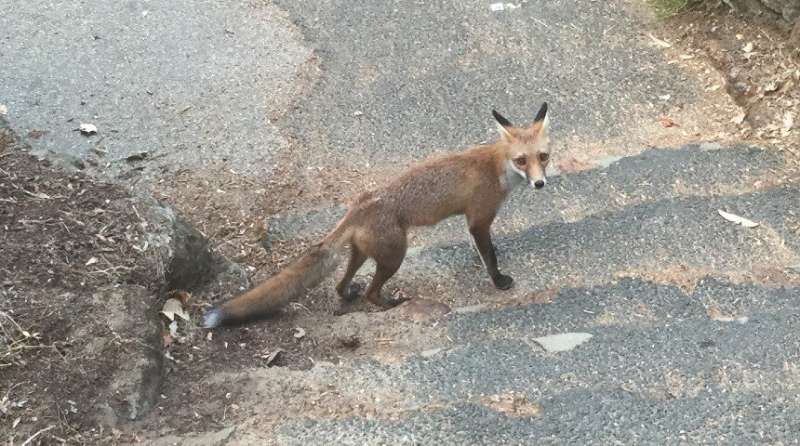Red fox in Kings Park, Western Australia. Credit: Professor Trish Fleming.
Scientists at Murdoch University's Harry Butler Institute (HBI) have discovered that red foxes are ravaging a larger range of Australian animals than previously realized, with 70% of fox diet samples turning up mammal remains.
The research demonstrates a major shift in fox diet over the past 70 years, as they have switched to consuming more native species in the wake of successful rabbit biocontrol.
Professor Trish Fleming, Director of the Centre for Terrestrial Ecosystem Science and Sustainability at HBI, says the fox is one of the greatest threats to Australia's native fauna.
"Unlike feral cats, which prefer taking only live prey, foxes are opportunistic, consuming a range of food, this opportunism is what has allowed them to exploit a broad range of habitats to become the most widely distributed carnivore next to domestic cats and dogs," said Professor Fleming.
"They never go without; they always find something that they can eat. Their opportunism makes the red fox the world's most successful wild mammalian carnivore. Foxes exploit a range of human environments from farmland to cities. As well as the significant threat to our biodiversity, foxes also cause significant damage to livestock."
Professor Fleming said the research provided valuable insight into the Australian mouse plague affecting parts of rural New South Wales.
"For study sites within mouse plague-prone parts of eastern Australia, we found no difference in the incidence of house mouse in fox diet between years with mouse plagues and years without plagues," she said.
"However, the incidence of house mouse in fox diet for these areas was approximately 2.3 times greater than the overall mean in other locations. This may suggest that foxes benefit from localized increases in mouse availability, even if the increase of house mouse in fox diet cannot counter the rapid reproductive rate of mouse populations under ideal conditions."
Professor Fleming and a team of collaborators from across Australia reviewed 85 fox diet studies, totalling 31,693 samples, from across the species' geographic range within Australia.
"This evidence is motivation for greater fox control in Australia, especially around urban bushland reserves where native species such as possums and bandicoots are a significant proportion of the foxes' diet. This review also highlights the importance of integrated pest species management for effective conservation of our unique biodiversity," said Professor Fleming.
"As a precautionary principle, population control of foxes, feral cats, and rabbits should be carried out simultaneously, because removal of any one of these species in isolation can have perverse repercussions for native wildlife."
The fox was introduced to Australia about 150 years ago, and within 30 years of its introduction was already recognized as a threat to livestock and native wildlife.
Earlier studies show the fox has already contributed to the extinction of an estimated 14 native mammal species and one bird species.
More information: Patricia A. Fleming et al, Diet of the introduced red fox Vulpes vulpes in Australia: analysis of temporal and spatial patterns, Mammal Review (2021). DOI: 10.1111/mam.12251
Provided by Murdoch University
























